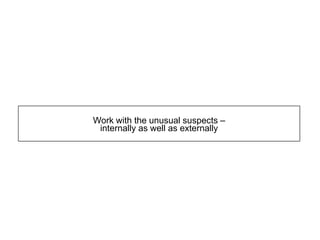Rethink Innovation!
- 1. Follow my work on LinkedIn Get in touch: stefanlindegaard@me.com Hey! Get free books, white papers and exercises on 15inno.com! Rethink Innovation!
- 2. Author, speaker and strategic advisor on corporate transformation based on disruption, digitalization and innovation. Get in touch! www.transform-or-die.com stefanlindegaard@me.com @lindegaard Stefan Lindegaard
- 3. Four global megatrends drive business today: Everything moves faster, everything will be connected, knowledge is transparent and disruption hits harder and faster.
- 4. Talk less about innovation!
- 6. How do you understand innovation? What does it mean to you? What is the corporate understanding of innovation?
- 7. The language of innovation and how people understand the term is vague and fuzzy at best; dangerous at worst. This can cripple organizations.
- 8. Name three companies to envy for their perceived culture of innovation!
- 9. You can’t copy Apple, Google and 3M. Get inspired, but don’t try to copy them. It does not make sense to talk about an innovation culture!
- 10. Getting ideas and working with them in the early stages is the easier part. The execution is what really matters. We have begun the transition phase.
- 11. The role of the CTO has changed as real value creation no longer is centered around technology or product itself. Services, processes and business models are key. The internal power needs to shift.
- 12. Disruption hits harder and faster
- 13. Disruption hits much harder and much faster than ever before. You can’t plan for disruptive or radical innovation, but you can be sure you will be disrupted.
- 14. What are the most important elements to master with regards to disruption?
- 15. 1. Internal setup (right conditions, frameworks, remove obstacles) 2. Market approach 3. Offensive as well as defensive approach
- 16. Focus on corporate transformation and digitalization – or die!
- 17. Why does transformation matter? Stay relevant, survive and prosper!
- 18. Don’t talk about innovation. Focus on how you can transform your company based on values, assets, partners, threats and opportunities.
- 22. The organizational structures need to change. They are not build for the upcoming challenges and opportunities and we need to experiment much more on what will work the best for the future of business.
- 23. Strong organizations do four things very well: They listen, adapt, experiment and execute better than their competitors.
- 24. How do you get started? What is the right structure? Experiment! A hint: Go all in on digital!
- 25. Work with the unusual suspects – internally as well as externally
- 26. What is open innovation / external collaboration? “…a philosophy or a mindset that they should embrace within their organization. This mindset should enable their organization to work with external input to the business processes just as naturally as it does with internal input” Open innovation as a term will disappear in 5-7 years!
- 27. 1. Common Language and Understanding, Motivation, Mandate and Strategic Purpose 2. Assets and Needs 3. Value Pools and Channels 4. Internal Readiness 5. External Readiness 6. New Skills and Mindset 7. Communications Strategy 7 Steps for Open Innovation Get the free book on 15inno.com – let´s have a session later!
- 28. External collaboration can only reach it’s full potential when all business functions get involved. Go beyond products and technologies; solve challenges, but don’t forget to pursue opportunities.
- 29. Learn to communicate better and differently – or fail!
- 30. If you want to change the perception inside your organization, the outside voice is the most important.
- 31. What’s the matter with Owen?
- 32. Owen is just fine. But what is going on with Ford Otosan?
- 33. What is communication today?
- 34. 1. Traditional communication (intranets, websites, PR) 2. Stakeholder management and networking 3. Social media
- 35. Focus on people and upgrade their mindset and skills!
- 36. People first, processes next, then ideas. The key for execution is people – don´t focus too much on ideas and projects.
- 37. Discovery – Incubation – Acceleration: Have the right people for the right project at the right time in the right context. Build people pools, not just project pools.
- 38. The TBX model or why middle managers stop…
- 39. • T (Top Down): Get executives onboard, personally committed to innovation. Without executive support, no change occurs • B (Bottom Up): Value creation begins with people, one by one, team by team. Nothing happens unless you get employees engaged • X (Across): Middle managers get the job done (for good and bad) – set the right objectives and incentives! ...innovation just by doing their job! Everyone ask themselves a very simple question: What´s in it for me? - know the answer before you start your initiatives.
- 40. Chart by BusinessInsider Strong change teams know they can´t do it by themselves; they become facilitators and integrators. Education is a key objective.
- 41. • The team itself • Employees • Managers • Executives • Key external stakeholders Who should be trained as value creators and corporate transformers? Guess what the most important group is – and also the most neglected one…?
- 42. A CFO is wary about investing in the training and education of the employees. He asks the CEO: ”What happens if we invest in developing our people and then they leave the company?” The CEO is a bright person and replies: ”What happens if we don’t and they stay?”
- 43. Follow my work on LinkedIn Get in touch: www.transform-or-die.com stefanlindegaard@me.com Join Transform – or Die! A movement for the people who own the future. Rethink Innovation!











































